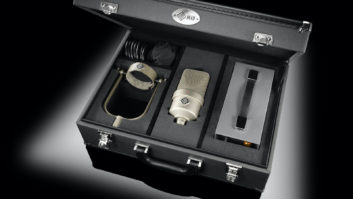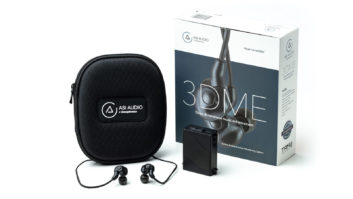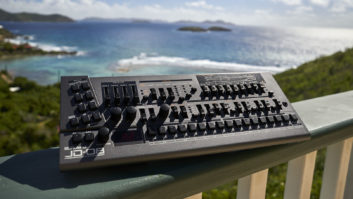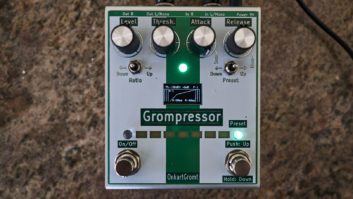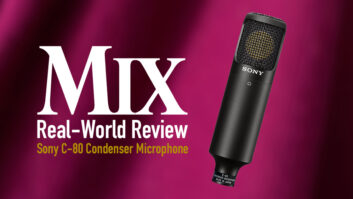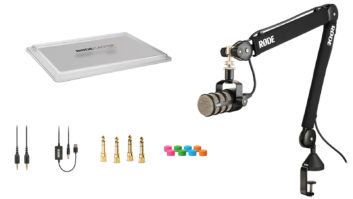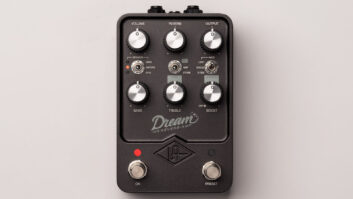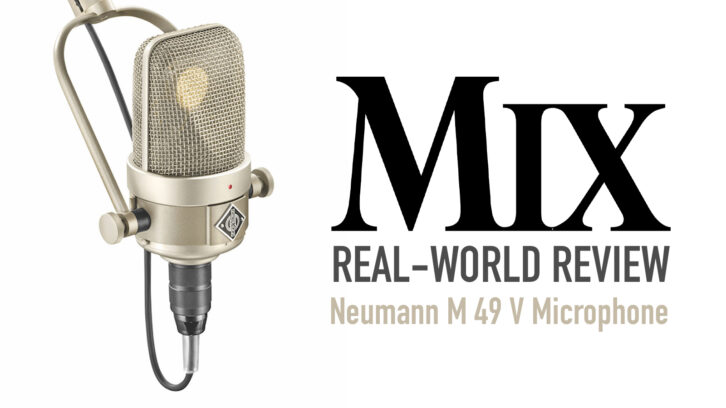
| MIX VERDICT: Neumann M 49 V Microphone |
| THE TAKEAWAY: “If you’ve wanted to get a completely updated classic tube condenser microphone, now might be the time! Super-highly recommended!” |
| COMPANY: Neumann • www.en-de.neumann.com PRICE: $8,499 MSRP PROS: • Awesome male and female vocal microphone. CONS: • Connecting cable seems delicate. • No shock mount basket offered as yet. |
The first prototype Neumann M 49 microphones were made in 1949 for NWDR—Northwest German Broadcast—and badged as B-M 49. The remotely controlled M 49 was an instant hit when it was first introduced and shipped in 1951; it was the first studio microphone to have a continuously variable polar pattern and, to this day, is still sought after by engineers and producers.
The notable revisions of the first M 49 were called the M 49 B and C, with the broadcast versions labeled M 249 B and M 249 C. M 49 microphones are considered one of the best condenser models for male and female vocalists. Prices for original, pristine, working examples sell for more than $15,000. The new M 49 V uses the same circuit as the M 49 C.
Each mic is hand-built to the original specifications and design documents from the Georg Neumann archives by the three Neumann employees trained and qualified to assemble the reissue, which means that there will be a limited number of M 49 V microphones produced each month.
The original M 49 used the same classic M7 large-diaphragm capsule as the one deployed in the (less expensive at the time) Neumann U 47. The M7 capsule has PVC diaphragms and was later replaced by the more durable K 49 capsule. The center-terminated, dual-diaphragm K 49 capsule is gold-sputtered Mylar with an outside diameter of 34 mm and a free working diameter of 26 mm. The thickness of the two diaphragms is not specified.
The M 49 V uses the same RF-proof, 7-pin Tuchel connector set as the broadcast version M 249, though Neumann reports that there will be no separate broadcast variant: “We refrained from adding complete ‘modern day’ EMC (electromagnetic compatibility) protection measures, as this would not be in line with classic design, and (we are) counting on that the M 49 V will be used in ‘controlled environments.’”
NEW TUBE AND POWER SUPPLY
The M 49 V uses a new pre-selected triode tube (Neumann has declined to disclose its type) to replace the no-longer-manufactured MSC2/AC701K Telefunken tube used in the original. The good news is that the new tube type enables the M 49 V to have lower self-noise than the classic M 49. Maximum SPL is 125 dB (there is no pad switch), S/N ratio is 74 dB, and sensitivity is measured at 8 mV/Pa.
The new tube requires 6.3 volts for the filament as compared to the Hiller MSC2 and later the Telefunken AC701k at 4.2 volts. This necessitated a new power supply called the NM V. The previous N 52 or NN 48 power supplies will not work properly with the M 49 V. Connecting the new mic with an old N 52/NN 48 will appear to work at first, but the under-heated filament will cause a very high noise floor and is not recommended.
I found it interesting that the new NM V supply powers up with 4.2 volts filament voltage and then “ramps up” to change to 6.3V when a new M 49 V mic is automatically recognized—this slow filament heating should help the tube to last longer before replacement.
It is possible to power any vintage M49 or M249 with the new NM V without damaging the MSC2/AC701 tube inside from excessive filament voltage. The NM V is a linear power supply, not a switch-mode model, and automatically adapts to 110 VAC or 230 VAC mains.
The new power supply has a smooth-operating polar pattern control knob for continuously varying between five different choices. These are: figure-of-8 bidirectional with deep side nulls at full CW; a sub-cardioid mode with broad rear lobes; a cardioid with rear null; a wide and broad cardioid; and omnidirectional at full counter-clockwise. Frequency responses and polar plots are listed for each of the five modes and shown in the manual.
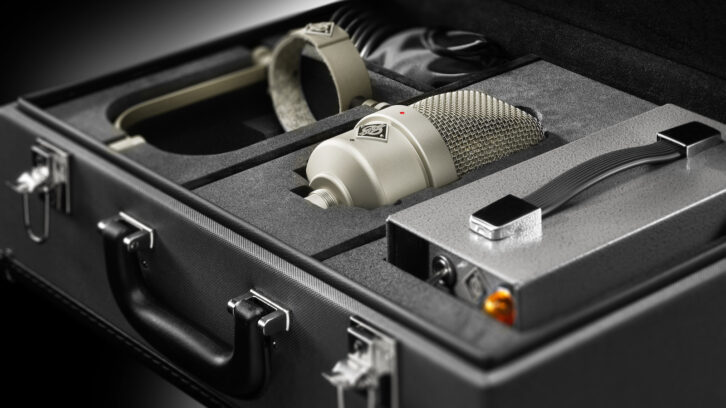
OTHER CHANGES
In keeping with the classic design, the same circuit and the same BV 11 output transformer wound to the original specifications are used as in the Neumann M 49 C. The first M 49s had an amplifier frequency response well down into the infrasonic range, but to protect the output transformer (from overloading and distortion) and also for practical reasons, a broadcast LF roll-off was added, starting at -2.3 dB @ 30 Hz up to -3 dB @ 40 Hz.
The M 49 V comes with the M 49 C’s first-order highpass filter set to 30 Hz, but there is an internal switch (S4) to change that to 12 Hz for extended low-frequency response and a very slight increase of distortion. A second internal switch (S2) locks the polar pattern to cardioid-only, like the original M 49, and at the same time increases sensitivity by 2 dB; a 3 dB increase in signal-to-noise ratio and self-noise is about 1 dB lower.
However, these two switches are not user-changeable. If your workflow is voice-over or overhead pickup only, you might consider ordering the mic in cardioid-only. Everything is the same in cardioid-only, and you may have the mic converted back to multi-pattern by Neumann.
(To change the settings of the internal switches, you should contact Neumann Service. If an unauthorized customer opens an M 49 V to change the switches, or touches the diaphragm and damages it, this is not covered by the warranty.)
The M 49 V comes in a cloth-covered wooden attaché style case that contains the microphone, gimbal style MZ 49A elastic holder, 10-meter (32-feet) KC 5 cable, and EU, UK and USA AC mains cables.
As delivered, I found the KC 5 cable a tangled mess. I tried the M 49 V on many sources, and I had to be careful where I laid down the connecting cable as it is of a small diameter and seemingly fragile, and could be easily cut by a cartage case rolling over it. I also thought there should be a shock mount “basket” accessory offered with this mic. The yoke mount’s rubber spacers on either side of the mic body are shock absorbers.
IN THE STUDIO
My first use for the M 49 V was a male vocal session. I had been using my house standard mic I know very well, David Bock’s U195 condenser. I used identical Sunset Sound S1P “Tutti” mic preamps both set to about 35 dB of gain for softer singing close in on both mics.
Both of these mics have large, dual-diaphragm, center-terminated capsules and large output transformers, but similarities end there, as the U195 uses an FET circuit and is cardioid-only.
The M 49 V had a slightly wider pickup pattern with a little more of the room tone captured. On this singer, I heard a little more bottom end—we used the same working distance on both mics.
Real-World Review: Avid MBox Studio and Avid Carbon Pre
Comparing the new M 49 V with an M 49 A was interesting. The 70-year old M 49 A came with a “V” yoke mount, but had no modifications and used a European Telefunken power supply that ran on 240 VAC. It compared well to the new M 49 V, as I found the old A had slightly more output level (the new M 49 V delivered in cardioid-only also has more output) but less low-frequency energy, more self-noise and a slightly “muddy” sound. The new M 49 V was dead quiet, and the low-frequency response was accurate.
Excellent uses for the M 49 V include orchestral brass in omnidirectional pattern and acoustic upright bass in cardioid about 18 inches out from the “F” hole—depending on the player, you can angle the mic toward the bridge if you need more attack. Overall orchestra pickup in omni works great, but some experimentation with the mic’s exact placement is required.
FEMALE VOCALS!
Of course, female vocals sounded amazing! I prefer singers very close to the mic, and the M 49 V in cardioid seemed to add just the right amount of thickness in the low-midrange frequencies but was not excessively bright and sibilant. My female singer could get right up on the mic and sing at any volume, though you will need a windscreen/pop filter.
During that session, I compared the M 49 V to a Telefunken U47 with M7 capsule and a Sony C-800G—all in cardioid pattern. I used three API 312V mic preamps, with the Sony putting out more level and the Telefunken and M 49 V about the same. Generally, the Sony seemed thin in the low-midrange by comparison and seemed a little bright—it also seemed to “pop” more readily than the others. That midrange “bark” you get with the Telefunken was also there in the M 49 V, just not as pronounced. I thought the M 49 V was overall smoother and more even-sounding, with no peaks from this particular singer.
The Neumann M 49 V is an excellent addition to both the company’s microphone line and its legacy. If you’ve wanted to get a completely updated classic tube condenser microphone, now might be the time! Super-highly recommended!
